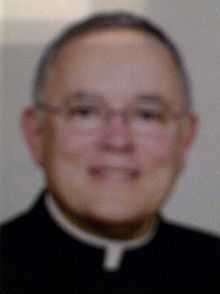Urban John Vehr
| The Most Reverend Urban John Vehr | |
|---|---|
| Archbishop of Denver | |
 | |
| See | Denver |
| Installed | November 15, 1941 |
| Term ended | February 18, 1967 |
| Predecessor | John Henry Tihen |
| Successor | James Vincent Casey |
| Orders | |
| Ordination | May 29, 1915 |
| Consecration |
June 10, 1931 by John T. McNicholas |
| Personal details | |
| Born |
May 30, 1891 Cincinnati, Ohio |
| Died |
September 19, 1973 (aged 82) Denver, Colorado |
| Buried | Mount Olivet Cemetery, Wheat Ridge, Colorado |
| Denomination | Roman Catholic Church |
Urban John Vehr (May 30, 1891 – September 19, 1973) was an American clergyman of the Roman Catholic Church. He served as Bishop of Denver from 1931 (raised to Archbishop in 1941 when the diocese became an archdiocese) until 1967.
Biography
The oldest of six children, Urban Vehr was born in the Price Hill section of Cincinnati, Ohio, to Anthony and Catharine (née Hamann) Vehr.[1] His father was a mechanical engineer.[2] After graduating from St. Xavier College, he studied theology at Mount St. Mary's Seminary of the West.[2] He was ordained to the priesthood by Archbishop Henry K. Moeller on May 29, 1915.[3] He then served as a curate at Holy Trinity Church in Middletown until 1923, when he became chaplain at the College of Mount St. Joseph.[1]
In 1924 he earned a Master of Arts degree in education from the Catholic University of America, and was then named superintendent of Catholic schools in the Archdiocese of Cincinnati.[1] He served as rector of St. Gregory Minor Seminary from 1927 to 1930, and was raised to the rank of Monsignor in 1927.[1] He earned a Licentiate of Canon Law from the Pontifical University of St. Thomas Aquinas (Angelicum) at Rome in 1928.[1] From 1930 to 1931, he served as rector of Mount St. Mary's Seminary.[1]
On April 17, 1931, Vehr was appointed the fourth Bishop of Denver, Colorado, by Pope Pius XI.[3] He received his episcopal consecration on the following June 10 from Archbishop John T. McNicholas, O.P., with Archbishop Francis Beckman and Bishop Joseph H. Albers serving as co-consecrators.[3] At age 40, he was the youngest Catholic bishop in the United States.[2] Upon arriving at Denver, he was installed at the Cathedral of the Immaculate Conception on July 16, 1931.[3] He soon visited every parish in the diocese, breaking the new Studebaker automobile given to him by the clergy of Colorado in the process.[2] However, the number of parishes fell from 111 in 1930 to 87 in 1940 due to the Great Depression.[2] Vehr greatly cooperated with the New Deal programs of President Franklin D. Roosevelt, including asking priests to offer weekly services at the two dozen Civilian Conservation Corps camps established in Colorado.[2] He also instituted a more organized system of diocesan affairs, and placed ownership of all parish properties in his person.[2]
When the Diocese of Denver was elevated to the rank of an archdiocese by Pope Pius XII, Vehr was named its first Archbishop on November 15, 1941.[3] The new archbishop was installed on January 6, 1942; one of the visiting dignitaries was Monsignor Giovanni Battista Montini (the future Pope Paul VI), who stayed in Vehr's residence.[2] Due to the conflict of World War II, he did not receive the pallium, a vestment worn by metropolitan bishops, until April 1946, when it was bestowed upon him by Cardinal Samuel Stritch.[4] He became an Assistant at the Pontifical Throne in 1955.[1] Vehr was committed to Catholic education and, under the slogan of "Every Catholic Child in a Catholic School," began a campaign to raise $3.5 million to acquire school sites and make additions to existing ones.[2] In 1965 he launched the Archdiocesan Development Program to accommodate Colorado's Catholic population, which tripled in size since his arrival in 1931.[2] He also erected forty-three new parishes and expanded St. Thomas Seminary, which reached its all-time peak of 274 seminarians during Vehr's tenure.[2] Due to poor health, the aging Vehr did not attend the Second Vatican Council (1962-1965) but instead sent his auxiliary bishop, David Monas Maloney, to represent him.[2] After thirty-six years at the helm of the Archdiocese of Denver, he retired on February 18, 1967; he was appointed Titular Archbishop of Masuccaba by Paul VI on the same date.[3] He resigned his titular see on December 31, 1970.[3]
Vehr later died at Denver, aged 82. He is buried at Mount Olivet Cemetery in Wheat Ridge.[5]
References
- ↑ 1.0 1.1 1.2 1.3 1.4 1.5 1.6 Curtis, Georgina Pell (1961). The American Catholic Who's Who XIV. Grosse Pointe, Michigan: Walter Romig.
- ↑ 2.0 2.1 2.2 2.3 2.4 2.5 2.6 2.7 2.8 2.9 2.10 2.11 Noel, Thomas J. "Vehr: The Flowering of Catholicism (1931-1967)". Colorado Catholicism.
- ↑ 3.0 3.1 3.2 3.3 3.4 3.5 3.6 "Archbishop Urban John Vehr". Catholic-Hierarchy.org.
- ↑ "People". TIME Magazine. 1946-05-06.
- ↑ "Rev Urban John Vehr". Find A Grave Memorial.
| Catholic Church titles | ||
|---|---|---|
| Preceded by John Henry Tihen |
Archbishop of Denver April 17, 1931 – February 18, 1967 |
Succeeded by James Vincent Casey |